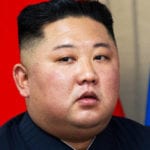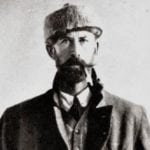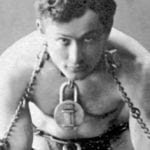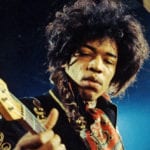10Arius (d. A.D. 336)
Arius, the Presbyter of Alexandria, believed that Christ was a lesser, separate being from God the Father. For this reason, he and his Christian followers were bitterly opposed as heretics by those who believed in the Trinity. This issue divided the fourth-century Church, and the pendulum swung as the Roman emperor Constantine alternately favored one faction over the other. In 324, the Council of Nicea condemned Arius, and Constantine banished him. The emperor soon got fed up with the continuing debate, however. He reinstated Arius, ordering Constantinople’s Patriarch Alexander to receive him at communion. Unable to disobey the imperial command, yet unwilling that the host should be desecrated by the heretic, Alexander asked his orthodox followers to pray that Arius die before he set foot in the church. Arius had an audience with the emperor at the palace then joined the procession of his followers to Alexander’s church. Suddenly, according to chronicler Socrates Scholasticus, Arius was seized by bowel cramps and sought the nearest toilet. There, his innards—spleen, liver, and intestines—erupted in a bloody mess, killing him. The orthodox called it a miracle of answered prayer; the Arians called it murder. By all accounts, 80-year-old Arius had been in good health when in conference with Constantine. It is entirely possible that poison was administered to him through the food and drink served there. The above account of his death in a toilet, written nearly a century after the fact, may be Catholic embellishment to further embarrass Arius and stain his memory. But his sudden and unexpected death ensured that suspicion will always hound the Trinitarians about their role in the tragedy.
9King William II Rufus (d. 1100)
William II was the second surviving son of William the Conqueror. Vain and ill-tempered, he ruled England badly. On August 2, 1100, William joined a hunting party that included his younger brother Henry in New Forest. The party split off into two groups, leaving William with a companion named Walter Tirel. He gave Tirel two of his six arrows, commenting, “It is only right that the sharpest arrows goes to the man who knows how to inflict the deadliest shots.” A short while later, one of those arrows was buried in his chest. Apparently, Tirel had aimed at a stag but missed, hitting the king instead and killing him. Such hunting accidents were common. William himself had lost his elder brother and a cousin to wayward arrows. Tirel fled the scene, presumably fearing the consequences of being blamed for William’s death. But William may not have been a victim of a simple accident. Could Tirel have been part of a plot to assassinate the king? William’s younger brother Henry, who succeeded him, certainly had a strong motive. And he galloped off in a hurry to secure the crown at Winchester, even as the servants were still carting away his brother’s body. Moreover, he became particularly generous to Tirel’s family. Was this to reward him for carrying out the murder? More recently, another theory was put forward that Tirel worked with a French agent, Raoul d’Equesnes, who wanted William dead to prevent his projected invasion of France. If so, the plot worked, for King Henry called off the invasion as soon as he gained the throne.
8King Charles XII (d. 1718)
Called the “Lion of the North” by his admirer Voltaire, Charles XII led his country of Sweden into disastrous conflicts that cost her dearly in men, money, and territory. Charles became unpopular with many Swedes for such needless sacrifices. In December 1718, Charles was leading yet another invasion, this time of Danish-held Norway. During the siege of the hilltop fortress of Fridrikshald, the king went to the front line to supervise the building of a trench. It was a dangerous spot well within range of Danish muskets. Charles exposed himself above the breastworks, and a bullet struck his head. Though there were many troops around Charles, no one witnessed the exact instant of his death. Questions arose. Did the bullet come from enemy fire, or was the king shot deliberately by one of his own men? Based on the orientation of the trench and where Charles was standing, a bullet coming from the left would indicate a shot from the fort; one from the right would point to a Swedish soldier as the triggerman. Charles skull contained two holes, one on each side, leading to unresolved debate over which was the entry wound and which was the exit. Documents show that some of the king’s companions behaved oddly just before he was killed. Prince Frederick, for one, exhibited extreme nervousness that only subsided after he heard Charles was dead. Frederick’s secretary, Andre Sicre, actually confessed to the murder while in feverish delirium, though he retracted the confession once he recovered. The king’s surgeon had a dream in which the dead king, when asked if the shot came from the fortress, replied, “No—One came creeping.” The strangest twist to this mystery was the discovery in 1924 of a curiously formed bullet made from a button in a gravel pit in Oxnevalla. Tradition says it was the very bullet that killed Charles, picked up by a soldier returning from Fridrikshald. Folklore said that Charles was impervious to ordinary bullets. It was theorized that the superstitious assassin made a bullet from Charles’s own coat button to penetrate the king’s supernatural shield. The theory seems ridiculous and farfetched but for one thing. Blood traces on the bullet matched DNA on Charles’s bloodstained gloves.
7Napoleon Bonaparte (d. 1821)
Traditional history says Napoleon died on May 5, 1821 from stomach cancer. The disease had earlier killed his father Carlo. But evidence purports to show traces of arsenic poisoning in Napoleon’s hair. The poisoning theory was popularized by Swedish physician Dr. Sten Forshufvud, who alleged an act of premeditated murder by one of Napoleon’s companions. Other theorists point out that the ingestion of arsenic was not necessarily murder. Arsenic was a common ingredient in many household products in the 19th century. A particular culprit has been singled out: a wallpaper color called Scheele’s green that was used in Napoleon’s home in St. Helena. The dye releases arsenic when it gets damp. It may well be that the emperor took in the arsenic from the environment. The theory has several flaws. Hair samples from Napoleon showed no more arsenic than those taken from his son and his wife Josephine. The man showed none of the characteristic symptoms of arsenic poisoning (in fact, Napoleon died obese, while chronic arsenic poisoning causes extreme weight loss). The cancer theory, however, is also unproven. Autopsy reports indicate that the cancer was not yet in an advanced stage, so he can only have died of complications (gastrointestinal hemorrhage rather than direct cancer). Absolute proof of cancer can only come from direct examination of body tissues, and Napoleon’s descendants refuse any access to his remains. So, we should expect this debate to rage on in the foreseeable future.
6Warren G. Harding (d. 1923)
The 29th president of the United States lived an unhealthy lifestyle that favored alcohol, cigars, and late-night poker games. He was the perfect candidate for a heart attack. In July 1923, Harding took a long, grueling trip across the country, with stops in Vancouver, Alaska, and Washington State. The president was clearly weak and tired and had to cancel his speeches in Portland and San Francisco. He died on August 2, 1923, officially due to “some brain evolvement, probably an apoplexy.” History records it as heart attack. Yet the four physicians attending to him during his last week could not agree on the exact cause of death. The autopsy that could have settled all questions was never performed—on the orders of the First Lady, Florence Harding. These suspicious circumstances suggested that something was being covered up. Accounts of the president’s final moments contradict one another. Harding seemed to be recovering from an attack of indigestion and pneumonia on the evening of August 2 and was in the company of Mrs. Harding in his hotel room. According to this version of events, Florence left to go to her suite, and a nurse came in and saw Harding’s face twitch. She raised the alarm, but Harding was dead. Another version put Dr. Charles Sawyer, a homeopathic doctor trusted by the Hardings, on the scene, ministering to the doomed president. If the president was killed, the strongest suspect would be the First Lady, who had the motive, means, and opportunity to carry out the assassination. Harding was a notorious philanderer and may have even sired a daughter by his lover Nan Britton. This was motive enough, but there was also Harding’s affair with a married woman named Carrie Phillips. Her husband had threatened the pair with exposure, and some suggest Florence killed Warren to stave off public humiliation. She could easily have administered poison when she was alone with her husband. Just over a year after the president’s death, Dr. Sawyer died in much the same way, after a visit from none other than Florence Harding. The possibility is thus raised: Did Florence commit the murder with help from Dr. Sawyer, and was he in turn killed to assure his silence? Florence died two months later, taking the secret with her to the grave.
5King Ananda Mahidol (d. 1946)
At about 9:20 on the morning of June 9, 1946, the sound of a gunshot shattered the quiet of the Grand Palace in Bangkok. A page rushed into the royal bedchamber and found the 20-year-old King Ananda Mahidol lying face-up on the bed, a bullet wound in his forehead and a Colt .45 by his left hand. Hours later, his younger brother Bhumibol was proclaimed king. Initial reports said the death was an unfortunate accident. Ananda loved firearms and had always kept one close. But in the following days, the possibility of suicide arose. The man had been depressed about his breakup with his Swiss girlfriend. He’d had intestinal problems and often quarreled with his mother. But the gun was found in the king’s left hand, while he was actually right-handed. By the end of the month, a commission of inquiry concluded that Ananda’s death was “definitely murder.” But who shot him? Louis Mountbatten, Earl of Burma, wrote to King George VI that “King Bhumibol shot his brother to obtain the crown.” Bhumibol was the last person to see Ananda alive. He testified to going into his brother’s room at 9:00 and leaving when he saw Ananda was still asleep. But no other evidence implicated Bhumibol. Another possibility was that Bhumibol killed his brother by accident, perhaps as they were playing around with the gun. The government eventually arrested three suspects: Ananda’s secretary and two servants, including the page who found the body. A fourth suspect was Premier Pridi Phanomyong, who evaded arrest by fleeing. Though evidence against them was sorely lacking, the three prisoners were executed by firing squad in 1955.
4Jan Masaryk (d. 1948)
Czech Foreign Minister Jan Masaryk was found dead in the courtyard of Prague’s Cernin Palace on the morning of March 10, 1948. The body lay directly beneath the window of his flat, so it was concluded that the 61-year-old Masaryk had committed suicide by jumping to his death. Masaryk had been the only liberal remaining in the government when the Communists took over in February 1948. He had been despondent in the days prior to his death, brooding about the situation of his country. His secretary, Antonin Sum, believed that Masaryk had sacrificed himself to protest Communist terror. Yet Masaryk left no suicide note that gave his motive. Only certified Communists were allowed to approach the body before it lay in state. Even the request of Masaryk’s personal physician to attend the post-mortem was turned down. A crowd of hundreds of thousands thronged Masaryk’s funeral, many thinking him a victim of assassination ordered by Stalin. Masaryk, a heavyset man, would have landed much closer to the building had he jumped. The body lay more than 2 meters (6.5 ft) away, indicating he was flung out by unknown assailants. Masaryk also landed on his feet, as if he were attempting to save himself from the fall. Traces of plaster under his fingernails suggest that he had clutched at the wall to escape being thrown out. The police doctor who wrote out the death certificate was himself found dead a few weeks later, also an apparent suicide. Russian authorities still refuse to provide the materials to help identify the killers. The Jan Masaryk case remains a mystery to this day.
3Emperor Haile Selassie (d. 1975)
Emperor Haile Selassie (meaning “Might of the Trinity”) of Ethiopia was a larger-than-life figure who traced his ancestry to the fabled biblical King Solomon and the Queen of Sheba. He was called the Conquering Lion of the Tribe of Judah and the Elect of God. He tried to bring his backward country into the 20th century, but he ruled as an autocrat. Unemployment, famine, and political ineptitude provoked an army mutiny against Selassie in 1974. Declaring the emperor deposed, military officers imprisoned him in a small apartment in his palace. On August 27, 1975, the Marxist military government announced that a servant had found the 83-year-old Selassie dead in his bed. The cause was presumed to be respiratory failure due to complications from a prostate operation. But many, including Selassie’s personal physician, didn’t buy this official version and claimed the emperor had been assassinated. Crown Prince Afsa Wossen, claiming his father had been in excellent health, demanded an autopsy. But Ethiopian custom decreed that the body must be buried within 24 hours, and it seemed the world had seen the last of the Lion of Judah. The remains were discovered only in 1992, buried under a concrete slab beneath a lavatory on the palace grounds. Selassie was finally given a decent burial in 2000, after an investigation into his mysterious death. Even then, many refused to believe Selassie was really dead, particularly the Rastafarians who claim that Selassie was the immortal Son of God. The bones, they argue, were too small to be those of the Emperor. Ethiopia’s High Court is satisfied that the bones are Selassie’s—and that his successor, the brutal dictator Mengistu Haile Mariam, strangled Selassie in his bed with his own hands.
2Pope John Paul I (d. 1978)
The gentle, smiling Archbishop Albino Luciani, an outsider to the Roman Curia, was elected Pope in August 1978. As John Paul I, he immediately showed his humility and refreshing simplicity by refusing to wear the papal tiara or be carried aloft on the papal chair. It was thus a grievous shock when he died on September 28 after a mere 33 days in office, apparently from heart attack. Conflicting testimony about his death soon raised questions of a Vatican cover-up, possibly murder. At first, it was reported that the body was discovered by the Pope’s secretary, John Magee, around 5:30 AM. It turned out that it was a nun, Sister Vincenza, who found the Pope in calm repose on his bed with some reading material in his hands. Such a posture did not suggest death by heart attack. No autopsy was ever performed on the body. The Pope, it is theorized, actually died from a dose of digitalis administered in the medicine he was taking for low blood pressure. The Pope’s missing slippers and eyeglasses were presumably removed because they were stained by vomit when the poison took effect. Later, officials explained that the items had been taken away previously by John Paul’s sister. It has been speculated that John Paul, who was already disliked by Vatican bureaucrats, was ready to clean up the scandal-tainted Vatican Bank of its reputed organized crime ties. So some find it suspicious that the bank’s president, Archbishop Paul Marcinkus, was seen hanging about the papal residence at an unusually early hour on the morning of the Pope’s death. Marcinkus deflected this by saying he was a habitual early riser. Suspicion also focused on the Pope’s secretary, who may have rearranged the Pope’s body to make it look as if he died peacefully. To counter the poisoning theory, it is claimed that the Pope died of pulmonary embolism. He had been suffering from violent coughs and pain the night before. But embolism could not have killed fast enough to explain John Paul’s serene posture on the bed. With no proper autopsy, the case of John Paul I remains open.
1Muhammad Zia Ul-Haq (d. 1988)
On August 17, 1988, Muhammad Zia Ul-Haq of Pakistan was returning to Islamabad on a Lockheed C-130 Hercules after watching a demonstration of an American battle tank in the desert. Ten minutes into the flight, the plane nose-dived and crashed to the ground. All aboard died, including US Ambassador Arnold Raphel and most of Pakistan’s top military brass. American investigators concluded that the plane had suffered a mechanical malfunction. Their Pakistani counterparts, however, became suspicious when they discovered snapped cables and problems with the elevator boosters that hinted at sabotage. Zia’s son Ijazul Haq accused Vice-General Aslam Beg of conspiring to kill his father. He claimed that Beg removed some of the plane’s wreckage to hide evidence of an air-to-air missile attack. Beg had refused orders to board the doomed plane. His motive might have been to prevent his impending replacement as vice-chief. Beg wasn’t the only one with a motive. There was no shortage of suspects who wanted Zia dead. There were the Indians, Pakistan’s traditional enemy. Or the Russians, irked by Zia’s jihad on the Soviets in Afghanistan. The Bhutto family, out to avenge Zia’s ouster and the execution of Prime Minister Zulfikar Ali Bhutto? Pakistani secularists, resisting Zia’s implementation of Sharia law? Shiite Iranians alarmed at Zia’s Sunni Islamic republic? The most intriguing suspect of all is the Mossad, the Israeli foreign intelligence agency. Mossad may have ordered the hit on Zia to prevent him from developing a nuclear bomb, which he could share with other Muslim nations and enemies of Israel. Indeed, Zia had ominously called his project the “Islamic Bomb.” But there is no solid evidence against any of these suspects. Zia’s murder, if murder it was, might forever remain unsolved. Larry’s main interests are history and chess. He is also a big fan of Agatha Christie.
























